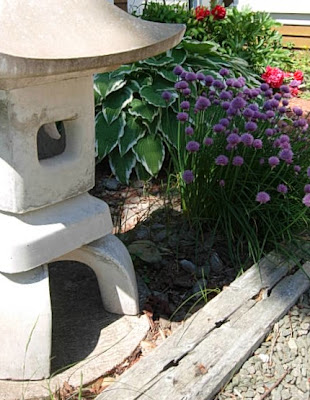No tourist item here, this bridal chest is classic domestic Korean furniture with the natural black lacquer, inlaid mother-of-pearl and heavy brass-work. A beautiful perfect storm of historic Korean folk artisan workmanship. It was made just after World War II, ca 1950, for a bride-to-be for her wedding trousseau and would have been carried---with her treasured articles and silk outfits protected inside---in perhaps a wedding-procession. It shows on either side of the unique butterfly brass lock, the bride-to-be with her chaperone on the left and the groom-to-be on the right, properly, appropriately separated before the wedding by the chaperone standing between them.
With all the always-present sense of humour of the Koreans that I have enjoyed both in Korea and among the many permanent-Korean-resident-friends and colleagues in Japan, on the top of the lid is the betrothed couple on the right, having struck a secret deal with the chaperone to allow them a few moments in each others' arms.
But the chaperone is still on the job, over in the left corner of the garden behind the rocks keeping an eye on her charges. She is the famous Korean 'match-maker', some of whom---especially blind go-betweens who are thought to have special gifts and powers in matchmaking---become famous and rather wealthy arranging matches that are both pleasing to the couple and appropriate for the 'wedding' of the two families.
The original owners, a Korean couple, brought two of these bridal chests with them as they immigrated to Canada sometime in the chaos after the Korean War to become part of the huge Korean population of Canadians who have contributed so much to the growth of post-war Canada. These Korean-Canadians gathered in urban areas around powerful Korean Christian churches and cultural centres.
So here are lessons from my mentor and friend for 20 years in Japan, Mr. LEE Yu-kwan of the famous Lee Family Collection, regarding Oriental Lacquer Art as applied to the construction of this beautiful piece.
The chest is 1. at its core a hand-crafted cedar box, 2. which was covered with raw lacquer (from the lacquer tree), a toxic brown paste-like substance, 3. into which is pressed rough-linen-cloth, completely encasing the chest to strengthen the wood core, 4. after which many layers of refined black lacquer are applied, 5. during which the hand-carved mother-of-pearl figures--prepared beforehand by specialist craftsmen---are pressed into the wet lacquer, 6, the layers drying but only with the presence of very high humidity---natural lacquer resin from the "urushi-no-ki" (lacquer tree) will never dry if in a dry atmosphere, 7. then finally with all layers dry. the lacquer craftsmen are able to polish down with pumas-stone the lacquer surface to a flat shiny very hard surface, whereupon a lacquer-artist can paint with gold-filled lacquer the design on the surface tying the figures and the story together. 8. To add pazazz to the restrained, dark richness of the bridal chest, the proud Korean brass fittings are applied.
The interior is covered with strip-designed cloth--a popular Korean pattern rather unlike either Chinese or Japanese fabric--to protect valuable Korean silk outfits from touching the interior wood surfaces. Rather primitive coarse pig-skin straps---indicative of the economic hardships of those war-ravaged times in Korea in the 50s and early 60s --- secure the lid, and very heavy brass hinges made from excessively thick brass---poor Koreans have always loved and treasured their brass while rich Koreans have always loved and treasure their brass and their gold---to make a strong and functional bridal chest that with the heavy brass handles and lock and hinges shows the 'wealth' and stability of the bride's family as they give away their daughter in marriage.





















